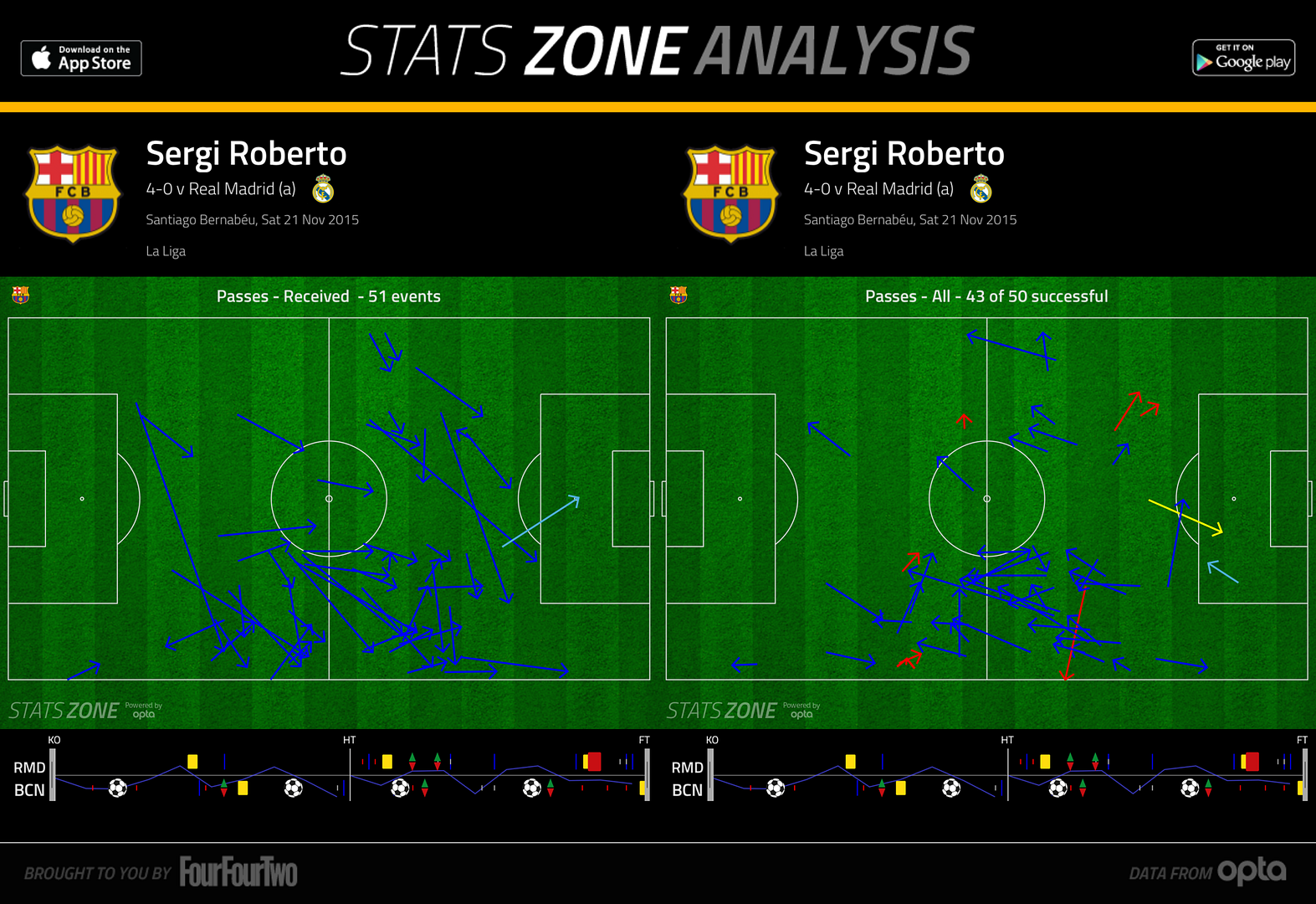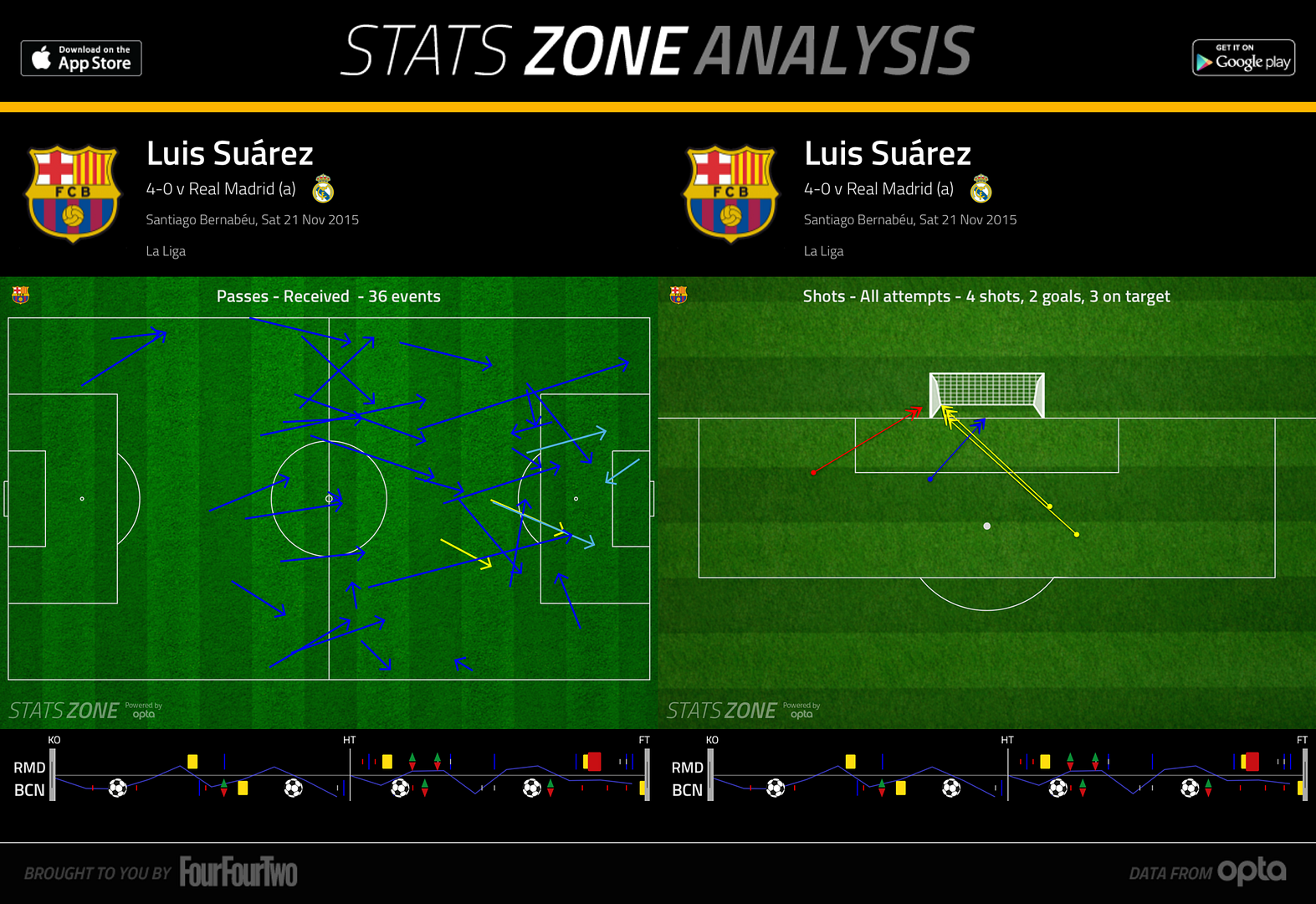Real Madrid 0-4 Barcelona: Real disorganisation allows Barca to run riot

Barcelona recorded an absurdly comprehensive victory at the Bernabeu, outplaying Real in midfield and cutting through their defence regularly.
Rafael Benitez chose a 4-2-3-1 system rather than the 4-3-3 he’s played in recent weeks, effectively omitting holding midfielder Casemeiro in order to accommodate his star attacking players. At the back, Raphael Varane and Marcelo returned in place of Pepe and Nacho.
Luis Enrique had fitness doubts over two players – Ivan Rakitic and Lionel Messi. Rakitic was declared fit to start, but Messi’s return from injury had to wait – he was a substitute, with Sergi Roberto starting on the right instead. Javier Mascherano started alongside Gerard Pique but limped off midway through the first half, replaced by Jeremy Mathieu.
Real started this game reasonably well and arguably dominated the first 10 minutes. Once Barcelona took the lead, however, it was one-way traffic.
Real system
The game’s defining feature was Benitez’s decision to play a 4-2-3-1 system rather than the 4-3-3 Real had played for the past five league games. In fairness, Benitez was really reverting to the system he started the season with (and the system he’s generally favoured throughout his coaching career), and the use of the 4-3-3 was really a temporary solution while Real coped with injuries to the likes of Gareth Bale, Karim Benzema and James Rodriguez. Nevertheless, omitting a holding midfielder was a very brave call.
Benitez had only played this midfield and attack once previously, a 5-0 thrashing of Betis. In that game, the two deep midfielders controlled possession and the other four had license to attack. Against Barcelona, however, the task is entirely different and Real simply didn’t have enough ball-winning quality in midfield. Managers can get around this problem with good organisation, as Carlo Ancelotti was doing this time last year with Real, but here they played with no holding midfielder and a completely fractured, disorganised approach without possession. That was the game’s key feature.
Real press
Real’s approach from the outset was to press energetically. They hurried Barcelona in the first five minutes and forced a few mistakes, with Bale moving forward to help Benzema press the centre-backs, and the rest of the side backing up behind, remaining compact and preventing Barcelona from playing through the lines. This is an approach Real have often used (regardless of the manager) reasonably effectively against Barcelona in the opening minutes of recent Clasicos, with Barca often needing 10 minutes to settle, for the tempo to cool and for them to find their passing rhythm. That’s essentially what happened again here.
Real were also determined to pass out from the back, even when they were pressed by Barcelona. There was one fantastic passing move, starting from Keylor Navas, which featured every Real player aside from Bale touching the ball as Real cut through the lines swiftly, with a low Cristiano Ronaldo cross-shot from the inside-right channel forcing Claudio Bravo into a decent save. In this sense, Real were essentially trying to play like Barcelona – pressing from the front, passing from the back.
Sergi Roberto
Barcelona took command of the game after 10 minutes when they opened the scoring through Luis Suarez. The key to the goal, however, was the positioning and movement of Sergi Roberto. A midfielder rather than a natural forward, he played in the midfield zone rather than up against Marcelo, effectively helping to overload Real in the centre of the pitch, the way Barcelona used to with Andres Iniesta in big games during the Pep Guardiola era.

With Real sometimes man-marking in midfield rather than keeping a solid shape, Sergi Roberto simply wandered in behind the Real midfield to receive a pass from Sergio Busquets (it’s notable how he points to where he wants the pass, seeing the wide open space) and slips in Suarez, making his typical lateral run to the outside. Sergi Roberto had touched the ball four separate times during the move.
For all Suarez, Neymar and Andres Iniesta’s brilliance, they shone when Barcelona were ahead – it was Sergi Roberto who was most crucial when this game was still a contest. He also showed intelligence to vary his movement, later going in behind to collect a wonderful diagonal pass from Iniesta, but it was mainly his movement into midfield which proved important. With Ronaldo staying high up the pitch, there was naturally a huge gap for him to collect possession away from Marcelo, and he also benefitted from Rakitic playing a little deeper than usual, tempting Kroos up the pitch. It created a perfect corridor of space, and while his passing was rarely ambitious, his positioning was vital.
Real woefully disorganised without the ball
At 1-0 (and again, it’s worth reiterating that they weren’t actually bad for the first 10 minutes) the home side collapsed. It’s difficult to understand precisely why this happened so dramatically- sometimes a side’s strategy changes when they concede, because they need to be more aggressive to get back into the game, but Real had been pressing anyway. It’s more likely, to put it simply, that their heads went down.
Without the ball, they were as disorganised as you’ll ever see from an elite, title-challenging side, and it’s particularly surprising considering this is a Benitez side. Everything was so poor that it’s difficult to focus on one particular area – there was simply so cohesion whatsoever.
Sometimes Benzema, Ronaldo and Bale would press but others would stay back (Rodriguez seemed in two minds about what he was supposed to be doing) meaning Barcelona could play out easily through Busquets.
Sometimes Ronaldo remained high and Real’s three midfielders had to cover too much space on the outsids, meaning Barcelona could attack easily in the wide areas with no pressure on the ball.
Sometimes Bale wasn’t in a position to close down Busquets, meaning he had time to orchestrate the play.
Sometimes, when Bale pressed the centre-backs, Kroos and Modric pushed forward to shut down Busquets and Iniesta or Rakitic, which inevitably left the other one completely unmarked (without even considering Sergi Roberto further overloading that zone). The centre-backs were unable to push forward into midfield because Suarez’s movement was so good, occupying them both simultaneously and pushed them back, the advantage of playing with a ‘true’ number nine.

At one point, all six Real players were in the left ‘half’ of the pitch without actually putting any pressure on the ball, which meant Barcelona could knock three easy passes from that zone – Iniesta, Neymar, Jordi Alba on the overlap – to switch the play, overload Danilo, and get in behind the Real defence.
Basically, the system fell apart. The 4-2-3-1 offered no compactness, and Benitez – the Sacchi discipline who always encourages his players to stay together and prevent space between the lines – would have been horrified to see the system looking more like 4-2-4 at times, and sometimes even 6-0-4.
Barcelona brilliance
All this shouldn’t hide the fact Barcelona often played extremely good football, and in such an open game their Barcelona’s three most talented players – Neymar, Suarez and Iniesta – were naturally their three star performers when Barca were ahead. Suarez’s movement was brilliant throughout and he also started the defensive pressure – he pressed Modric to win the ball for Barcelona’s second, which saw Iniesta teeing up Neymar. The Brazilian was the only Barcelona attacker always fighting against the same opponent – he ran Danilo ragged – but here the Real right-back was caught out ahead of the ball, with Varane distracted by Suarez’s movement and allowing Neymar too much freedom.
For the third, Iniesta was allowed too much space between the lines, combined with Neymar, and smashed in. But there was a familiar theme – a crucial part of the goal was again Suarez’s movement to the outside, creating space for Iniesta to switch from the inside-left to the inside-right channel.
The fourth goal saw Suarez going in behind to score – intriguingly, the crucial pass came from Alba, in a central, ’second striker’ position and again helping to cause Real problems between the lines. There was so much space there that even Barcelona’s left-back was able to exploit it.
Messi emerged with half an hour remaining, as was presumably always the plan. But whereas Luis Enrique might have anticipated summoning him to win the game, the game was already won. Messi couldn’t have wished for a gentler reintroduction.
Conclusion
To put the blame squarely upon Benitez would be unfair. He surely would have appreciated the importance of Casemeiro, and more than anyone else, he preaches compactness. There’s surely something else at play here: presumably Benitez feeling compelled to use all his star players at the expense of a cohesive system. The omission of Casemiero, and the change in system, made no sense tactically.
With that focus on superstars – which has plagued Real for years – it was somehow fitting that the player who put Barcelona in charge was Sergi Roberto. From the teamsheets, he was the least celebrated player, its only non-international, and only present because of injury. Nevertheless, his deep, narrow positioning caused Real all kinds of problem – and and his drift inside, and neat pass to Suarez, was the moment which changed the game. From there, Real’s openness allowed Suarez, Neymar and Iniesta to shine.




